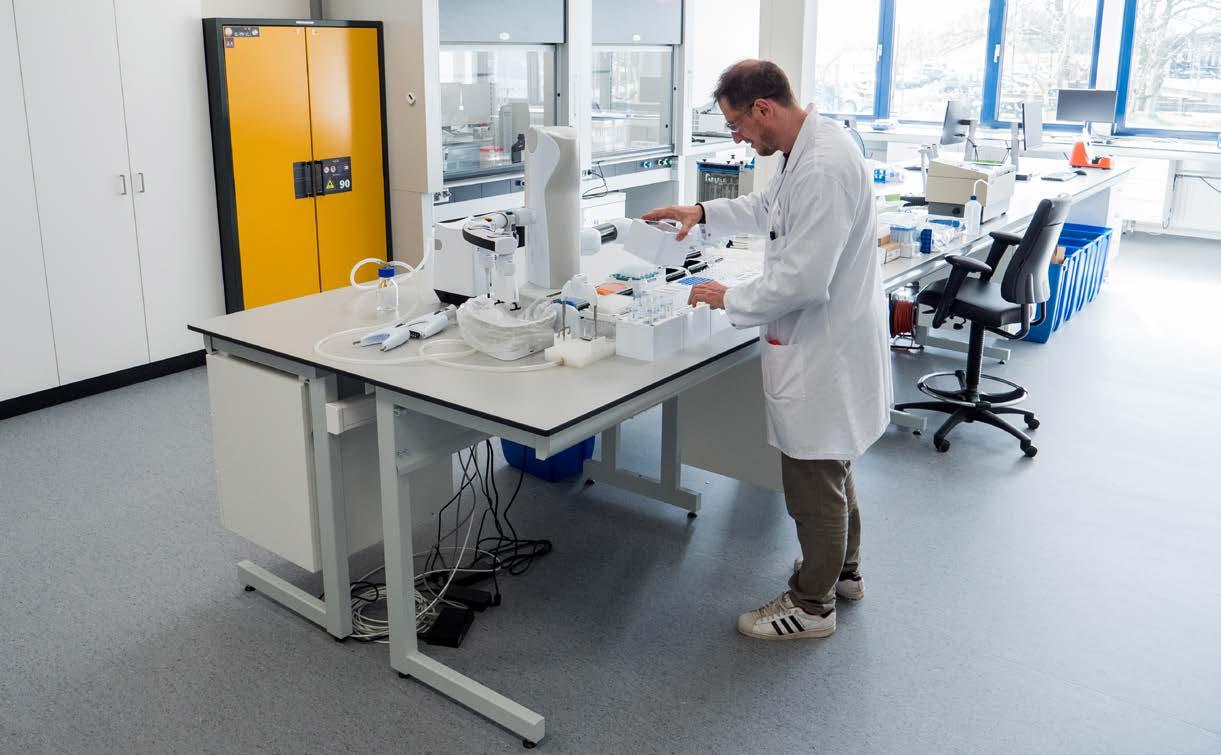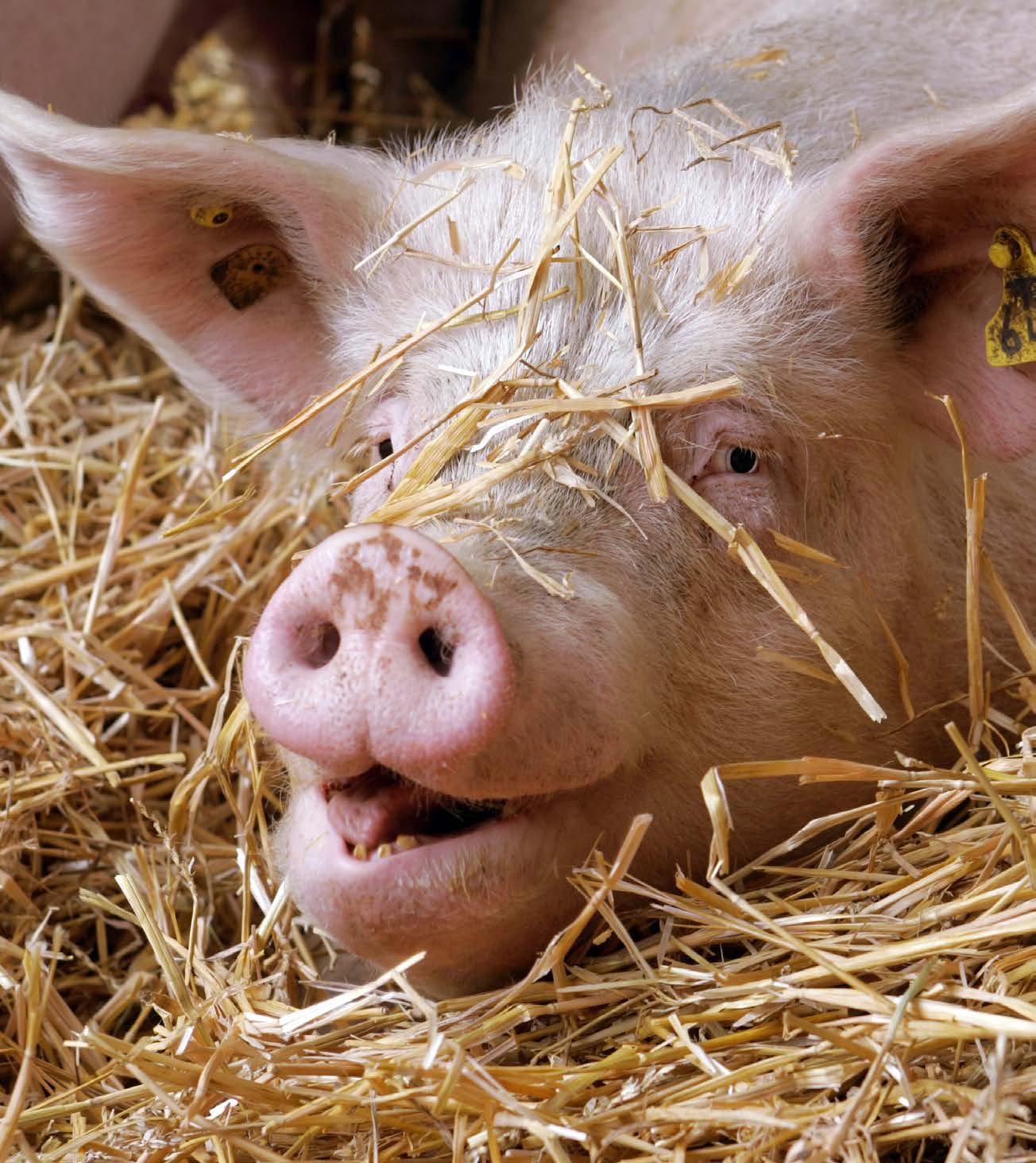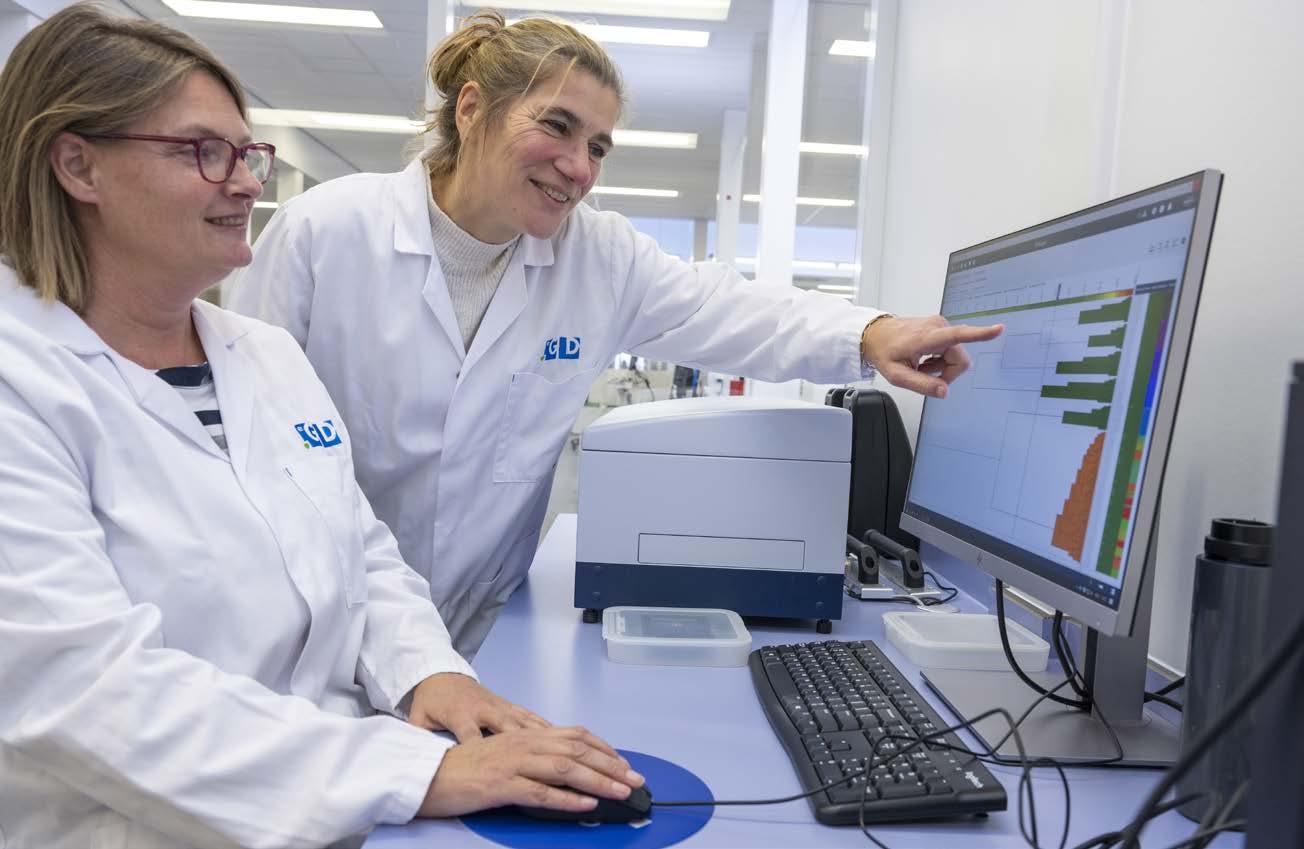








Why participate?
1. To evaluate laboratory performance
2. To identify problems
3. To maintain or achieve ISO 17025 accreditation
4. To identify interlaboratory differences
Application and questions
More information about our PTS and the application form can be found on our website www.gdanimalhealth.com/PTS.
If you have any questions, please do not hesitate to contact us via pts@gdanimalhealth.com or www.gddiergezondheid.nl/ klinischedagenrund
View the entire schedule: www.gdanimalhealth.com/pts/timeschedule
VLDIA233
VLDIA171
VLDIA295
VLDIA347

Welcome to our first Update of 2024. This year promises to be an exciting one for Royal GD. As you can read in this issue, we hope to open a new animal facility as well as an analytical chemistry lab. Our new animal facility will double our capacity for housing pigs and open up a range of possibilities we currently cannot offer. The analytical chemistry laboratory will be used for the analysis of organic molecules, which allows us to perform residue, pharmacokinetic and bioequivalence studies. Through this addition to our portfolio we strengthen our position as your partner in pre-clinical and clinical development even further.
In this edition we introduce you to two of our key employees in the execution of GCP clinical studies, Jobke van Hout and
Lianneke Bosma. They speak about their experience with GCP and its importance when running field studies. GD’s close connection with the field is one of our unique strengths. It gives us access to field strains, helps us understand the needs of the market and provides a unique network for the execution of clinical studies. The latest example of our close relation to the field is described in the article about our monitoring of circulating influenza strains among pigs in The Netherlands on page 7.
I hope that after reading through this Update you share my excitement about the level of activity going on at our company. Through continuous research, development and innovation, like the FTIR technology described on page 9, we are continuously working on improving animal health, worldwide. Berend







Berend Oosterhuis Head of Contract Research & Consulting b.oosterhuis@gdanimalhealth.com
Annemiek Kolkman Business manager a.kolkman@gdanimalhealth.com
Jarno Smit Sr. Account Manager j.smit@gdanimalhealth.com
Mattheus Hekman Business manager m.hekman@gdanimalhealth.com
Sebastiaan Bierma Business manager s.bierma@gdanimalhealth.com
Tetiana Kopniak Account Manager t.kopniak@gdanimalhealth.com






Eveline Peereboom Business manager e.peereboom@gdanimalhealth.com
Fanny Nieuwenhuis Business manager f.nieuwenhuis@gdanimalhealth.com

Ellen Koetsier Sales support support@gdanimalhealth.com
Janine Boertien Sales support support@gdanimalhealth.com
Hannelore Braamr Sales suport support@gdanimalhealth.com


Good Clinical Practice (GCP) is intended to be an international ethical and scientific quality standard for designing, conducting, monitoring, recording, auditing, analyzing and reporting clinical studies evaluating veterinary products. If you are looking for a Contract Research Organization for conducting veterinary clinical trials, Royal GD can offer you all these activities covered by GCP. In this article we talk to Jobke van Hout (Monitor and Principal Investigator) and Lianneke Bosma (Monitor in training).
Compliance with the GCP standard provides public assurance about the integrity of the clinical study data, and that due regard has been given to animal welfare and protection of the personnel involved in the study, the environment and the human food and animal feed chains.
A few years ago, Jobke van Hout started a training to become a Monitor. She has a veterinary background and regularly acts as Investigator in GCP field trials. “In the training you also gain experience by shadowing an already certified Monitor. I have learned a lot from that experience. GD can now cover various aspects of GCP studies: Investigators, Monitors, Quality Assurance and, of course, laboratory support when needed. Our laboratory works according to GLP standards, which aligns well with GCP.” Lianneke is in the final phase of her training and works in the Research and Development department of GD: “As an animal scientist I have been involved in animal studies. As a R&D researcher I am involved in quality work. Becoming a Monitor fits in well.”
In GCP responsibilities are shared by clinical investigators, institutions, institutional review boards, industry Sponsors and government regulators. It comes with a few challenges, such as
defining clear roles and responsibilities of those involved and ensuring a dynamic process in which contributions are complementary. We can ensure this dynamic process by combining the different aspects that are needed to conduct clinical trials; from the scientific knowledge of animal diseases to setting up a trial design, networking with veterinarians and livestock farmers in the field to veterinary laboratory practices, data collection, Quality Assurance, (statistical) analysis and processing of the data into a Final Study Report.
A Sponsor should ensure that the clinical trial is adequately monitored. Jobke: “As a Monitor, you are responsible for overseeing a clinical trial and ensuring that it is conducted, recorded, and reported correctly and according to various standards. In addition, the Monitor is the principal communication link between the Sponsor and the Investigator. Verifying the veracity of the information collected is one of the Monitor’s basic tasks. It must be decided and specified befhorehand, what information is to be checked against source documents, and what exactly these documents are. In practice, this means a wide variety of activities. The Monitor is on-site at critical moments in a trial. For example, on the day an Investigational
“Our laboratory works according to Good Laboratory Practice (GLP) standards, what aligns well with GCP”

Veterinary Product (e.g. vaccine) is administered. During this visit the Monitor checks whether all activities are carried out in consistency with the established Study Protocol.”
Lianneke adds: “You check that the used equipment is calibrated and working properly. For instance, is the temperature logged correctly during storage of the Investigational Veterinary Products? But also, are animals treated according to the random treatment allocation plan? You make sure that there is no possibility of misinterpreting of a recorded detail, in other words you check that all the data in a file is recorded correctly. And of course you consult with the Investigator or Sponsor on specific issues. My experience is that everyone always cooperates well, because together you want to ensure that the study is carried out correctly. Only then can it possibly lead to marketing authorisation of a new veterinary medicine.”
A Monitor is an individual appointed by the Sponsor responsible for monitoring and reporting on progress of the study, verifying the data and confirming that the clinical study is conducted, recorded and reported in compliance with VICH (International Cooperation on Harmonisation of Technical Requirements for Registration of Veterinary Medicinal Products), GCP and applicable regulatory requirements. The Monitor is the principal communication link between the Sponsor and the Investigator. The Monitor should have scientific training and experience to knowledgeably oversee a particular study. The Monitor should be trained in quality control techniques and data verification procedures. Furthermore, the Monitor should understand all applicable Study Protocol requirements and be able to determine whether the study was conducted in accordance with the Protocol and relevant SOPs. An individual should not serve as both the Monitor and Investigator for any one study.

Our veterinary diagnostic laboratory already is one of the largest and most modern laboratories in the world. To maintain our status as one of the leading organizations in the field of animal health and to serve our clients in the best possible way, we are building a new animal facility and analytical chemistry lab.
Adjacent to its current BSL-2 animal facility GD is building a new, 250m2 large, BSL-2/3 facility. “Our current facility is stateof-the-art and one of the largest of its kind with over 70 operational isolators. However, our floor pen capacity is relatively small”, says Berend Oosterhuis, head of Contract Research & Consulting at GD. “We regularly have to turn down requests for studies or postpone them due to a limited capacity in our floor pens. In addition we often get requests for studies we simply cannot run in our current facility.”
The new facility will double the number of floor pens to 12 in total. The facility will consist of three small (10 m2) and three large (40m2) rooms. One of the small rooms will be a BSL-3 room, the other rooms will be BSL-2. The maximum capacity for housing poultry and pigs will more than double. In addition to poultry and pigs, the facility will also be suitable for hosting small ruminants and calves. “The aim of the new facility is not purely to increase the animal capacity but to widen the breadth of studies that we can facilitate”, continues Berend. The new
facility adds a number of possibilities to our current offering such as hosting pregnant sows, working with BSL-3 grade pathogens and performing small surgeries.”
The new facility is expected to open in the fourth quarter of 2024.
Besides the new animal facility, we are also setting up a new analytical chemistry lab. The laboratory space has already been built and currently the equipment is being installed and validated. Method validation is expected to start by March 2024 and end in December 2024 . More than 50 methods will be developed. The laboratory will be equipped with Triple Quad LC-MS/ MS systems and the plan is to add later on a High Resolution MS to the equipment. Berend: “The new laboratory will be used for routine residue testing but also opens up multiple opportunities for contract research. With the addition of this new analytical laboratory to our capabilities we can now also offer PK, Bioequivalence and Residue studies to our pharmaceutical clients.”
The laboratory is expected to open in 2025.
Berend: “We are very proud of these developments and can’t wait to start. If you want to know more about the new facilities and the possibilities they open up, contact our team.”

Swine influenza is a zoonosis, nothing new so far. However, the concern of a potential new pandemic originated from swine influenza is increasing among society and policymakers. There is the possibility of co-infection of avian and mammal influenza strains at the same time in a pig with the risk of evolution into influenza variants of concern, the influenza pandemic in 2009, the Covid-19 pandemic in 2020 and the last outbreaks of highly pathogenic avian influenza in poultry in several European countries.
Surveillance and monitoring are essential for a prompt detection of new potential risks. Up-to-date consistent data on the prevalence and evolution of influenza strains in pig farms, however, is often lacking. Note that swine influenza is not a notifiable disease and therefore, swine influenza surveillance programmes lack consistency in many countries.
Dutch influenza surveillance
In the Netherlands, the pig sector (farmers and veterinarians) voluntary participated in a swine influenza surveillance pilot last year (2022-2023) led by Dutch Animal (GD, WBVR) and Human Health (RIVM, EMC) partners (report can be found here). Thanks to this pilot, we now have a better idea about the identity and epidemiology of circulating influenza viruses in the Dutch pig population as well as the risk that these strains can pose to the public health. The main currently circulating Influenza subtypes are the already known H1N1 and H1N2. H3N2 was only found in one farm. This lower proportion of H3N2 is also frequently reported in other European countries.
Although it was not the focus of this pilot, no avian influenza H5 was identified in any of the pig samples. Results from a recent study from Germany showed that pigs have low susceptibility against experimental infection with highly pathogenic avian influenza virus H5N1 (Graaf A. et al., 2023. Emerg Infect Dis). At this moment, the risk of infection of pigs from conventional farms with highly pathogenic avian influenza seems to be low. In one farm, strains isolated from pigs clustered together with human influenza strains, based on data of the Dutch influenza surveillance programme in humans. This supports the known human-to-pig transmission of influenza strains. Seasonal influenza vaccination and protection measures for farm personnel and visitors are therefore essential measures to prevent or minimize this transmission and eventually, the risk of occurrence of new variants.
The swine influenza pilot in the Netherlands is being continued in 2024, as well as other European and National projects where Royal GD is involved together with other partners (see box). We will learn more about the evolution of Influenza strains and will increase our knowledge on the inter-species transmission. These projects, amongst others, enable GD to keep advancing our diagnostic capabilities and research capacities.
ESFLU, European Swine Influenza Network:
• Consortium led by CEVA Santé Animale:
• Objectives: To strength capabilities to detect, identify and characterize swine influenza virus, facilitate data sharing with National and International agencies, to promote the dialog between different stakeholders and to provide guidelines for the management and control of influenza in pig farms.
Strong1H, Strengthening One Health Surveillance:
• Consortium led by Rijksinstituut voor Volksgezondheid en Milieu.
• Aim: To collect data on influenza A (among other viruses) in different domestic and wild animal species and share it through a One Health platform, and to assess its application for the identification of national risks and priorities, among others.
MOEDIG, Molecular Epidemiological Diagnostics for Intervention Options for Flu (Influenza) on Pig Farms:
• Consortium led by: Avans university of Applied Science.
• Aim: To improve molecular epidemiological diagnostic methods for detecting Influenza A viruses in pigs.
PPS Influenza;
• Consortium led by Wageningen Bioveterinary Research
• Aim: to assess risks of porcine IAV transmission for human and animal health and provide practical tools for intervention options.
Simply identifying the presence of a bacterial pathogen is often not enough to determine the appropriate control strategy. It is increasingly necessary to determine specific characteristics of the pathogen in question. Our laboratory has a new technique at its disposal to analyse bacteria below their species level: Fourier Transform Infrared (FTIR) spectroscopy.
Using specific software, the infrared spectra of different isolates of the same bacterial species can be compared and classified into different clusters. This helps to make informed choices in pathogen control.
Atoms in a chemical compound are constantly moving in relation to each other. FTIR spectroscopy makes it possible to mea-
sure these intramolecular vibrations. Just as coloured substances absorb light, the vibrations in chemical compounds allow them to absorb infrared frequencies. The amount of light absorbed at each frequency depends on the chemical composition of the compound. The infrared spectrum of a bacterium therefore reflects the biochemical composition of the bacterial cell and can be regarded as a biochemical fingerprint.

Quicker and cheaper
FTIR spectroscopy is a fast and relatively inexpensive technique. But it is not an easy technique. Annet Heuvelink works as a bacteriologist in our R&D department. “The difficulty is that we have to make a pure culture, a population of cells originating from a single cell, under conditions that are always identical. This means that there are strict limits on incubation temperature and time. The growth medium is also a critical factor. Only when validated protocols are strictly adhered to, it is possible to make a good comparison. Not only between isolates tested in the same run, but also between new isolates and previously tested isolates. It is important to build up a database of spectra generated under exactly the same conditions. In addition to the standardised method required to produce a pure culture, accuracy is essential when producing a suspension of the colony material for application to the target plate, which is then inserted into the instrument. This process of preparing a suspension of colony material and then generating a spectrum takes several hours, after which the spectra can be compared using dedicated software to determine if there is a “relationship”. Currently, FTIR cluster analysis is generally available for:
• Erysipelothrix rhusiopathiae
• Escherichia coli
• Klebsiella pneumoniae
• Listeria monocytogenes
• Mannheimia haemolytica
• Pasteurella multocida
• Salmonella Typhimurium
• Staphylococcus aureus
• Streptococcus agalactiae
• Streptococcus uberis
• Streptococcus suis
The technique is available on a project basis for other bacteria.
Problems caused by Pasteurella multocida
In a poultry farm, the previous flock (‘A’ in 2022) experienced increased mortality due to Pasteurella multocida. Based on the Pasteurella multocida isolates in flock ‘A’, the following flock (‘B’)
was vaccinated during the rearing period. In 2023, the same poultry farm faced another outbreak of Pasteurella multocida in the current flock (‘B’). Several isolates from this poultry farm were examined using FTIR cluster analysis. The two Pasteurella multocida isolates from the 2022 outbreak (flock ‘A’) that were included in the autovaccine were similar based on the infrared spectrum. These isolates were compared with six bacterial isolates from the current flock (‘B’). These six isolates were similar to each other based on their infrared spectrum, but different from the isolates from the previous outbreak. This is reflected in the separate clusters encoded as ‘A’ and ‘B’ (see figure).
Using FTIR to control Streptococcus suis
As a vet on a pig farm, it is important to know which strains of a particular bacteria species are present. This is necessary to determine the correct strategy for controlling the bacteria. In pig production, this is important for the control of Streptococcus suis. An important question is whether the clinic in piglets is caused by the same strain or whether, on the contrary, there is a wide variety of Streptococcus suis strains. It is possible that they cause different clinical problems. A comparison can be made between strains found in different organs or in the form of a historical survey. Validation studies carried out by GD prior to the introduction of this FTIR technique showed that there were pig farms where Streptococcus suis isolates collected from a single farm produced the same IR spectrum, whereas Streptococcus suis isolates from other pig farms produced many different IR spectra per farm.
The only way to know how much variation there is in Streptococcus suis strains on a single farm is to test regularly. After all, you only know for sure that there is only one type circulating on the farm having tested several clinical cases and compared the cultured isolates. It is difficult to say how often samples should be taken. It depends on so many individual farm factors. The basis is always to keep a historical record of which strains have been observed on a farm and what the clinical signs of animals with streptococcal infection have been.
READ MORE ABOUT FTIR
Dendrogram of the infrared spectra of the tested Pasteurella multocida isolates: the eight isolates can be divided into two groups, the isolates from 2023 (‘B’) clustering together, but not with those from 2022 (‘A’).

Monitor, evaluate, and improve your laboratory’s performance with our proficiency testing schemes. Participate in PTS Round 6 for:
• Bacterial Identification cattle
• Antibiotic susceptibility of bacterial strains cattle
• Bacterial Identification swine
• Antibiotic susceptibility of bacterial strains swine
We look forward to receiving your application by August 9, 2024. For more information, the PTS schedule of 2024, and the application form, please visit our website.
Our contract research team will be attending the joint congress of the European Symposium of Porcine Health Management (ESPHM) and the International Pig Veterinary Society Congress (IPVS) in Leipzig, Germany June 4-7 2024. You can also meet up with us at the European Poultry Conference (EPC) in Valencia, Spain June 24-28 2024. Visit our booth to learn more about our contract research possibilities, such as; GLP studies, new animal models e.g. swine influenza and avian influenza, increased capacity at of our facilities and novel testing methods.

Highly Pathogenic Avian Influenza (HPAI), or Bird Flu, has become a global issue. The virus is now present in wild birds on six continents and the use of sanitary control measures alone may no longer be a sustainable solution to effectively contain the disease. The time has come to move away from the systematic mass culling of flocks as the main measure to control HPAI. We need to consider the use of safe and effective vaccines in combination with proper monitoring and surveillance to control this disease. Research is well on the way and GD is currently carrying out field tests in laying hens. In the shadow of the global H5 outbreak, the H9N2 strain is also endemic in many countries. A new animal model has recently been developed to test vaccines against this strain.

Recently, our swine expert, Lucía Dieste Pérez, DVM MSc PhDr, gave an update on the latest advances in influenza research and diagnostic tools in an online expert session. She explained the clinical picture in the field, control tools and insights into current circulating influenza virus strains.
As of 1st of February 2024, the PathoSense diagnostics analysis for the Dutch market will be executed exclusively by GD. With just one sample, PathoSense analysis can identify all viruses and bacteria that can affect an animal. A helpful check that provides insight into which pathogens can cause health problems. PathoSense is a novel veterinary diagnostic assay which makes use of nanopore sequencing (Oxford Nanopore Technologies) to detect all viruses and bacteria in a sample, without having to make a prior selection. “Due to this collaboration GD and PathoSense are reinforcing each other. This allows veterinarians and farmers to take full advantage of these new diagnostic capabilities.” explains Saskia Luttikholt, Business Manager at GD. “Within the collaboration, GD will take care of performing the analyses for the Dutch market and following up the results with the corresponding advice.”

René van den Brom is European specialist in small ruminant health management. He is a member of the Expert Group on Animal Diseases of the Ministry of Agriculture, Nature and Food Quality. This is a group of experts advising the Ministry regarding animal diseases. The outbreak of bluetongue serotype 3 in the Netherlands has been high on the agenda since September 2023. “Vaccination is being studied further by pharmaceutical companies. We are looking at questions like: will the virus return and in what form? What preventive measures can we take? What are the lessons learned so far?”
In 2008, René started working at Royal GD. In 2020, he became head of the department for small ruminant, equine, and companion animal health at GD. He also works as an European veterinary specialist in small ruminant health management with an extra interest in surveillance of small ruminant health and infectious causes in small ruminants.
Bluetongue
In September 2023, bluetongue returned to the Netherlands and caused a lot of damage and excess mortality. GD’s epidemiology department carried out an impact analysis. More than 37,000 additional sheep died between September and October 2023 compared to previous years. Sheep over one year of age seem to be more susceptible to the virus than lambs under one year of age. “It is unclear from where BTV-3 was introduced into the Netherlands. This specific strain has not been found anywhere else. It is genetically different from the ones found in Sicily and Israel. To be able to make risk assessments, to take preventive measures and to reduce the risk of future introductions, worldwide sequencing of BTV-strains is important.”
We can be proud of the veterinary infrastructure in the Netherlands, says René. “The outbreak was detected early in an early phase of the disease thanks to surveillance. The veterinarians and farmers in the field were very vigilant and notified the clinical suspicion. Thanks to the cooperation between Wageningen Bioveterinary Research (WBVR), the sector parties, the government and GD, the virus was quickly detected and mapped. At GD, we have investigated the pathological findings of this for the Netherlands new serotype and were able to draw up an evaluation framework for treatment. In the previous outbreak vaccination was the most effective preventive measure. Now that we lack a vaccine farmers wish to apply other preventive measures. Housing of vulnerable animals reduces the risk of infection, although this measure will not prevent all infections since biting midges can also be present in stables. What 2024 will bring in terms of bluetongue remains uncertain.
Overwintering of BTV-3 is suspected to be likely. During the previous BT-outbreak most infections were seen in August and September of the second year. We sincerely hope that an effective vaccine will be available by that time.”
